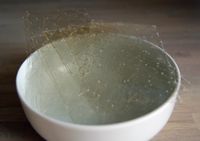
Photo from wikipedia
Because of the difference in osmotic pressure, most tough hydrogels swell under physiological conditions, which seriously weakens their mechanical properties, limiting their applications in biomedicine. Herein, a novel strategy based… Click to show full abstract
Because of the difference in osmotic pressure, most tough hydrogels swell under physiological conditions, which seriously weakens their mechanical properties, limiting their applications in biomedicine. Herein, a novel strategy based on strong and high-density micelle cross-linkings is proposed to construct non-swellable and tough hydrogel. To realize strong micelle cross-linker, the synergetic effect of hydrophobic and quadruple hydrogen-bonding interactions is constructed by introducing alkyl chain-protected ureido pyrimidinone (UPy) moiety into segmented copolymer backbone. The length of alkyl is the key factor in determining the strength of hydrophobic interaction, which was carefully tailored to gain micelles with high strength and suitable solubility. A supramolecular hydrogel was formed in-situ by simply linking micelle cross-linkers with polyethylene glycol (PEG) chains. The strong and high-density micelle cross-linkings restrain multiple effective chains outside the micelle from stretching during swelling, and the deformability of micelle cross-linkings disperses the local stress to maintain the network with high cross-linking density upon loading. Therefore, the hydrogel exhibited an outstanding non-swelling behavior under physiological conditions, and excellent mechanical property with a compressive strength of 4 MPa. The rapid in-situ gelation also facilitated injection and cells encapsulation. Meanwhile, it also showed good tissue adhesion, cytocompatibility, and suitable degradability. This novel and facile strategy can offer new insights into the exploitation of cross-linkings to prepare non-swellable hydrogels for the biomedical application.
Journal Title: Biomacromolecules
Year Published: 2019
Link to full text (if available)
Share on Social Media: Sign Up to like & get
recommendations!